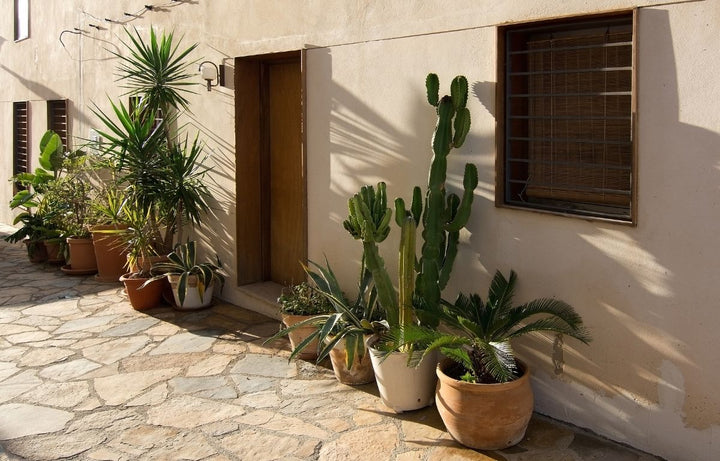
Sun Loving Plants Suitable For Pots
Sun Loving Plants Suitable For Pots
Sun-tolerant plants possess adaptations such as water-storing structures, thick leaves, and efficient photosynthesis. These traits help minimise water loss, endure heat, and easily convert sunlight into energy, allowing these potted plants to thrive in dry and direct sun-exposed conditions indoors and outdoors.

Water Storing Succulents and Cacti
Unlike other plants, succulents and cacti create energy through Crassulacean Acid Metabolism (CAM). This photosynthetic pathway allows them to open their stomata at night, when it's cooler and less humid, reducing water loss during the day. Along with thick leaves and stems, this allows the plants to store water making them well-suited for consistently bright and sunny areas, and thriving with minimal care during the drier seasons.
-
Agave: Not only are Agaves able to store water in their fleshy leaves, but they are slow growing and conserve energy. This allows the plant to build up defences making them more resilient to extreme temperatures and enabling them to withstand harsh sunlight.
- Barrel Cactus (Echinocactus spp.): These round-shaped cacti have a reduced surface area minimising the plant's overall exposure to harsh sunlight. The Barrel Cactus also has a water-storing stem, protective waxy coating, and natural adaptation to arid environments, ensuring survival in intense sun exposure.
- Burro's Tail (Sedum morganianum): These plants thrives in bright sunlight due to their succulent nature, and have similar adaptations to the Agave. They are slow-growing and store ample moisture in the leaves.
-
Jade Plant: Jade Plants have thick leaves that store water as well, making these plants resilient in hot and sunny positions. However, they do require acclimatisation or the leaves can burn if exposed too quickly. Slowly introduce the plant to sunny positions in incremental stages.
- Opuntia (Prickly Pear Cactus): Their thick pads store water and the spines create a microclimate that reduces water loss, while efficient photosynthesis helps them thrive in intense sunlight making them the perfect plant for full sun-exposed and dry climates.
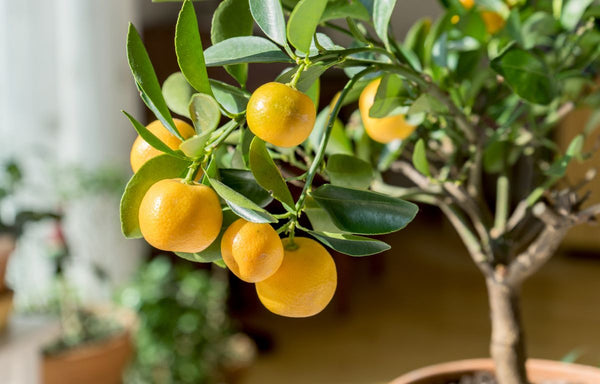
Plants Suitable For Direct Sunlit Spaces, Indoors and Outdoors
Thick leaves store water, while waxy cuticles and sunken stomata reduce water loss. Camouflage or reflective leaf structures mitigate heat stress. These adaptations, combined with efficient photosynthesis and biochemical defences, enable plants to thrive when exposed to direct sunlit environments.
- Bromeliad Vriesea spp: Bromeliad Vriesea can tolerate direct sunlight to some extent due to their adaptation to areas with high light exposure. They thrive in morning and evening sunlight, but can tolerant direct mid-day sun for short periods.
- Casuarina Cousin It: Casuarina Cousin It plants have fine, pendulous foliage that helps protect them from intense sunlight, reducing water loss through transpiration, and enabling them to thrive in sunny conditions.
- Cycad: Cycads have evolved over millions of years to withstand bright sunlight through adaptations like tough, waxy leaves, and specialised structures that reduce water loss and protect against excessive light exposure.
- Silver Falls (Dichondra): Dichondra plants produce tiny, inconspicuous flowers in ideal conditions of full sun to light shade and well-drained soil. Proper sunlight and consistent moisture promote flowering in these ground-hugging plants.
-
Ponytail Palm (Beaucarnea recurvata): The Ponytail Palm adapts to direct sunlight with its succulent base storing water and thick, cascading leaves reducing water loss, enabling it to thrive in sunny conditions.
-
Hoya carnosa: This popular Hoya variety is often more tolerant of direct sunlight compared to some others. The plant's thick, waxy leaves retain moisture and offer protection from UV radiation and heat.
- Yucca: Yucca plants endure direct sunlight through succulent leaves that store water, a narrow leaf surface area, waxy coatings that minimise water loss, and slow growth.
- Citrus Trees: Citrus trees thrive in direct sunlight due to their native origins in sunny climates. Abundant sunlight supports vigorous growth, enhances fruit development, and ensures optimal photosynthesis for healthy, productive trees. They are able to tolerate direct sunlight due to their thick, glossy leaves that offer shade, efficient water uptake, and well-developed root systems. Dwarf Citrus varieties are suitable for growing in pots.
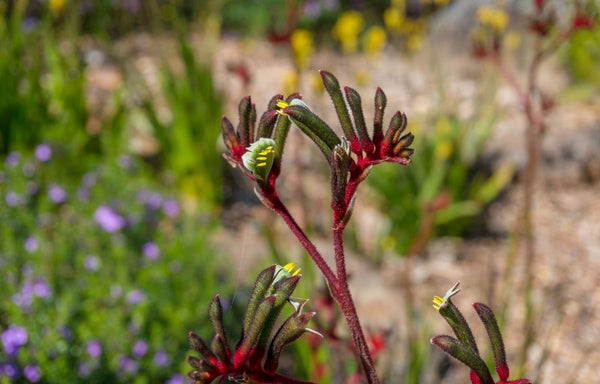
When In Doubt, Choose Australian Native Plants
Most Australian Native plants are ideally suited to sun-exposed areas due to their evolution in the continent's challenging conditions. Their ability to withstand intense sunlight, heat, and dryness, along with water-efficient traits and unique beauty, make them perfect choices for potted balconies and outdoor spaces.
-
Dwarf Bottlebrush (Callistemon spp.): Dwarf Bottlebrush flourish in direct sunlight due to their heat and sun tolerance, compact size, and vibrant bottlebrush-like flowers that add colour to any garden.
- Dwarf Eucalyptus (Eucalyptus spp.): Some dwarf eucalyptus varieties can thrive in large pots and tolerate full sun. This species has adapted to withstand direct sunlight through features like small, leathery leaves that reduce water loss, and they thrive with minimal shade.
-
Geraldton Wax plants (Chamelaucium uncinatum): Their waxy leaves are adapted to reduce water loss caused by dry direct sunlight exposure, and the tiny white and purple flowers add a delicate pop of colour.
-
Kangaroo Paw (Anigozanthos spp.): This iconic Australian Native, Kangaroo Paw plants are adapted to withstand direct sunlight through features like strap-like leaves, hairy textures, and rhizomatous roots that store water.
-
Grevillea: Grevillea plants are adapted to withstand direct sunlight with features such as tough, leathery leaves that reduce water loss and vibrant, bird-attracting flowers.

Sun Loving Flowering Plants
Sun-loving flowers require lengthy periods of direct sunlight per day because they have evolved to thrive in its abundant energy, using photosynthesis to convert sunlight into vital nutrients for growth, blooming, and overall health.
If you are purchasing established plants, make sure you select ones that have an abundance of new buds and very few open ones. This ensures that your plant has not already spent its flowers for the season and you can enjoy the colourful blooms for longer.
- Bougainvillea: These drought-tolerant vibrant flowering vines thrive and require ample amounts of sunlight to photosynthesise and support flower development and blooming. Without sufficient sunlight, the plant's energy production is limited.
- Geranium (Pelargonium): Very similar to the other sun flowering plants, Geraniums are versatile flowering plants that do well in full sun due to their thick, fleshy leaves that store water, reducing water loss. They come in a variety of different colours that thrive the longer the plant is exposed to direct sunlight.
-
Lantana: These colourful flowering plants are able to withstand direct sunlight through their succulent leaves, which reduce water loss. They are able to withstand hot and sunny weather while attracting pollinators.
- Lavender plants (Lavandula spp.): Lavender plants thrive in direct sunlight due to their natural adaptations, including sun-loving foliage, efficient water retention mechanisms, and heat-resistant properties, enabling them to flourish in sunny environments.
-
Marigold (Tagetes): Marigold plants are adapted to withstand direct sunlight with their robust foliage that provides shade to the soil, aiding moisture retention, and their heat tolerance, making them suitable for sunny locations.
-
Portulaca (Moss Rose): Portulaca features succulent-like leaves that retain water making the plant drought-tolerant, thriving in hot and dry sunny areas.
-
Sunflowers (Helianthus): Sunflowers thrive in direct sunlight due to their ability to pivot their faces to follow the sun (heliotropism), maximising light exposure for efficient photosynthesis and growth. Sunflowers can also be grown indoors when placed in sunny window positions.
- Zinnia: Native to Mexico, Zinnias are heat-tolerant annual flowers with a wide range of colours. Like with Bougainvilleas, these plants need constant, bright sunlight to flower. Their sturdy stems shade the soil for moisture retention making them well-suited for sunny environments.
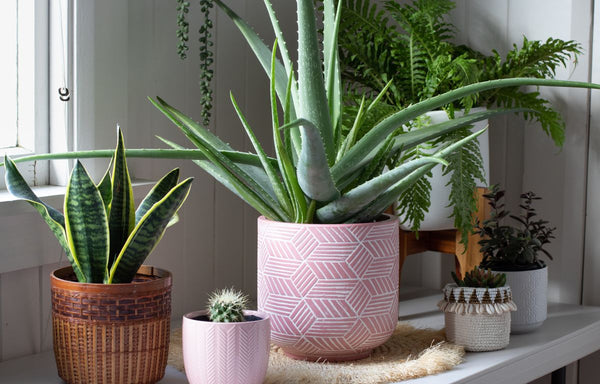
Indoor Plants That Can Tolerate Bright Sunlight In Moderation
Although most indoor plants prefer bright, indirect sunlight there are some that are able to withstand brief periods of intense direct sunlight. They do best with acclimatisation, so start by slowly introducing higher levels of direct sunlight to your plant a little at a time.
- Aloe Vera (Aloe barbadensis miller): Aloe Vera plants can withstand direct sunlight to some extent, but they are generally more accustomed to thriving in bright, indirect sunlight. While they are a succulent, they do have some natural adaptations that make them somewhat sun-tolerant, prolonged exposure to intense, direct sunlight can be harmful.
- Fiddle Leaf Fig trees (Ficus lyrata): Fiddle Leaf Figs can tolerate direct sunlight when acclimated gradually. Their large leaves adapt to filter sunlight, reducing the risk of sunburn and maintaining healthy growth. However, consistently high humidity is vital for healthy growth. They are Ideal for sunny indoor spaces or tropical outdoor climates.
- Swiss Cheese Plant (Monstera deliciosa): While Monstera can tolerate some direct sunlight, it's essential to be cautious. A few hours of morning sun or gentle, filtered sunlight is usually better than intense afternoon sun. Prolonged exposure to strong, direct sunlight can cause leaf burn or sunscald, particularly on the more delicate, variegated varieties.
- Pothos: Pothos plants prefer indirect sunlight. However, their sturdy and hardy nature gives them the ability to withstand varying bright conditions, including partial direct sunlight, without succumbing to light-related stress.
- Philodendron Selloum (Philodendron bipinnatifidum): This variety, also known as the Split-Leaf Philodendron, can tolerate some direct sunlight, especially in the morning or late afternoon. Its large, deeply lobed leaves help protect it from intense sunlight.
- Snake Plant (Sansevieria): Snake plants are known for their low-maintenance nature and can tolerate various light conditions, including some direct morning or late afternoon sun, as well as very dim natural light.
- Umbrella Plant (Schefflera ): While Umbrella Plants prefer bright, indirect light, they can adapt to tolerate some direct sunlight due to their large, compound leaves that provide shade, their natural habitat adaptation to filtered light, and their resilient leaf structures.
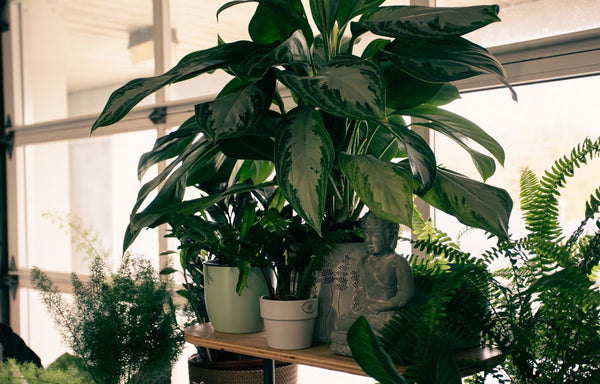
Avoid Plants That Are Native To Shaded Areas
Plants that are unsuited to direct sunlight conditions generally have delicate leaves or prefer shaded conditions, making them vulnerable to sunburn and stress in intense dry sunlight.
- Chinese Evergreen (Aglaonema): Direct sunlight is harmful to Aglaonema plants because they originate from shaded forest floors, making them adapted to low-light conditions, and intense sunlight can lead to leaf damage and sunburn.
- Ferns: Many ferns have delicate fronds that are prone to sunburn and dehydration in intense sunlight. Ferns are adapted to low-light environments, lacking the protective structures to withstand direct sunlight.
- Peace Lily (Spathiphyllum): Peace Lilies have thin leaves that allow them to efficiently capture and utilise limited available light for photosynthesis. This adaptation supports their survival in the dimly lit forest floors where they naturally thrive but makes them sensitive to direct sunlight which can easily scorch the leaves.
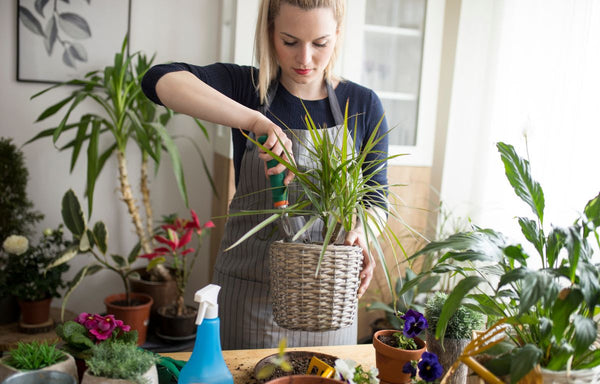
Caring for Sunlight-Tolerant Plants
Maintaining direct sunlight-tolerant plants requires careful attention.
- With the exception of succulents and Australian Native plants, regular watering of the soil is crucial to prevent drought stress and dehydrated roots, and replace water that has been lost due to transpiration.
- It is recommended to water your plants in the evenings when the sun is less concentrated and the moisture can be absorbed overnight.
- Be careful to not spray the leaves when watering. The combination of water droplets on leaves and direct sunlight can create a magnifying glass effect, concentrating sunlight and potentially causing burns or scorch marks on the leaves.
- Well-draining soil ensures healthy root systems and prevents root rot and other diseases.
- Pruning removes damaged leaves and encourages growth. It also allows good airflow around the soil and base of the plants which helps them cool down.
- Fertilising with balanced nutrients supports robust development, especially important during the warmer months as this is the time of year when most plants get an added boost in growth.
- Insects and pests are often sensitive to direct sunlight and use plants to shelter themselves from exposure. Regularly check underneath the leaves, around the nodes on the stems, and the surface of the topsoil.
When placing indoor or young plants in direct sunlight, it's important to monitor them closely for signs of stress, such as burned or faded leaves. Gradually acclimate your plants to higher light levels to prevent shock. Additionally, be mindful of the indoor humidity levels, as some plants may need extra humidity when placed in sunny locations. If you're unsure about the specific light requirements of a particular indoor plant over the summer season, it's always a good idea to research or consult with a knowledgeable horticulturalist or nursery professional.
